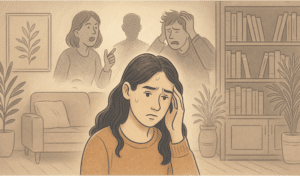Key Takeaways
- Schizophrenia affects 1 in 300 of the global population and can severely impact daily life if not managed properly.
- Asenapine is a second-generation antipsychotic that effectively treats schizophrenia by balancing dopamine and serotonin levels in the brain.
- Asenapine is typically taken as a sublingual tablet that must dissolve under the tongue and not be swallowed, with no eating or drinking for at least 10 minutes afterward.
- Common side effects of Asenapine are drowsiness, dizziness, and weight gain, which can often be managed with lifestyle adjustments and regular communication with healthcare providers.
- A Mission For Michael (AMFM) offers comprehensive and personalized schizophrenia treatment using evidence-based approaches including medication management, CBT, and holistic therapies.
What is Schizophrenia
Schizophrenia is a chronic and severe mental health disorder that affects how a person thinks, feels, and behaves. Individuals with schizophrenia may seem like they have lost touch with reality, which can be distressing for them and those around them. 1
Prevalence
Schizophrenia affects approximately 1 in 300 people worldwide. While it can occur at any age, it typically emerges in late adolescence or early adulthood. Men tend to experience symptoms earlier than women. 2
Impact on Daily Life
The impact of schizophrenia on daily life can be profound. Individuals may struggle with maintaining relationships, holding a job, or even performing daily tasks. This can lead to feelings of isolation and frustration.
| A Mission For Michael: Expert Mental Health Care Founded in 2010, A Mission For Michael (AMFM) offers specialized mental health care across Southern California, Washington, and Virginia. Our accredited facilities provide residential and outpatient programs, utilizing evidence-based therapies such as CBT, DBT, and EMDR. Our dedicated team of licensed professionals ensures every client receives the best care possible, supported by accreditations from The Joint Commission and the California Department of Health Care Services. We are committed to safety and personalized treatment plans. Start your recovery journey with AMFM today! |
Causes of Schizophrenia
Genetic Factors
If someone has a family member with schizophrenia, their risk of developing the disorder is higher compared to the general population.
Environmental Influences
Environmental factors, such as prenatal exposure to infections, malnutrition, or psychosocial stressors, can increase the risk of developing schizophrenia. These factors may interact with genetic predispositions to trigger the disorder.
Brain Chemistry
Imbalances in neurotransmitters like dopamine and serotonin are believed to contribute to schizophrenia’s symptoms. 3
Symptoms of Schizophrenia
Positive Symptoms
Positive symptoms refer to the presence of behaviors not typically seen in healthy individuals. These include:
- Hallucinations: Seeing or hearing things that aren’t there
- Delusions: Strongly held false beliefs
- Disorganized thinking: Incoherent speech and difficulty organizing thoughts
Negative Symptoms
- Reduced expression of emotions: Flat affect and lack of facial expressions
- Decreased motivation: Difficulty initiating and sustaining activities
- Social withdrawal: Avoidance of social interactions and activities
Negative symptoms can often be mistaken for depression, making accurate diagnosis crucial.
Cognitive Symptoms
Cognitive symptoms affect memory, attention, and the ability to process information. These can include:
- Difficulty focusing or paying attention
- Problems with working memory
- Challenges in understanding and processing information
These symptoms can significantly impact a person’s ability to function in daily life, making treatment essential. 4
Types of Schizophrenia

Schizophrenia can present in various forms, each with distinct characteristics. Understanding these types can aid in identifying the disorder and tailoring treatment plans.
Paranoid Schizophrenia
Paranoid schizophrenia is characterized by intense delusions and auditory hallucinations. Individuals may believe others are plotting against them or trying to harm them. Despite these challenges, they often retain cognitive functioning and emotional responsiveness.
Disorganized Schizophrenia
Disorganized schizophrenia involves disorganized speech and behavior, along with inappropriate emotional responses. Individuals may struggle with daily tasks and social interactions, making it one of the more disabling forms of schizophrenia.
Catatonic Schizophrenia
Catatonic schizophrenia is marked by extreme motor behavior. This can range from complete stillness to excessive, agitated movement. Individuals may also exhibit peculiar movements or mimicking of others’ actions. 5
Asenapine & How It Is Used for Schizophrenia
Asenapine, marketed under the brand name Saphris, is a medication primarily used in the treatment of schizophrenia and bipolar disorder. It falls under the category of second-generation antipsychotics, known for their ability to address both positive and negative symptoms of schizophrenia. 6
Schizophrenia requires a long-term treatment approach, and asenapine helps in managing the symptoms. By helping to stabilize mood and reduce the severity of hallucinations and delusions, asenapine can significantly improve an individual’s quality of life.
Administration Instructions
Asenapine is typically administered as a sublingual tablet – it is placed under the tongue to dissolve. It should not be swallowed, as this reduces its effectiveness. Avoid eating or drinking for at least 10 minutes after taking the medication to ensure proper absorption.
Consistency is key when taking Asenapine. Follow the prescribed dosage schedule and not to skip doses, as this can lead to a relapse of symptoms. If you miss a dose, take it as soon as you remember, unless it is close to the time for your next dose.
How Asenapine Works
Dopamine and serotonin are two key neurotransmitters involved in mood regulation and perception. Schizophrenia is often linked to an imbalance in these chemicals, leading to symptoms like hallucinations and delusions. Asenapine works by blocking specific dopamine and serotonin receptors, helping to normalize their levels in the brain.
By inhibiting these receptors, Asenapine can reduce the overactivity of dopamine that contributes to psychotic symptoms. This mechanism is central to its ability to improve both positive and negative symptoms of schizophrenia. 7
Asenapine’s Effects on Schizophrenia
Asenapine can lead to a marked improvement in the quality of life for those with schizophrenia. By reducing the severity of positive symptoms, such as hallucinations and delusions, individuals can engage more fully in daily activities and social interactions.
Negative symptoms, such as lack of motivation and social withdrawal, can also be mitigated with asenapine. This can lead to improved relationships and a greater ability to participate in work or educational pursuits.
Additionally, asenapine offers long-term benefits for individuals with schizophrenia such as decreased risk of relapse and a more stable mental state, which can contribute to better overall well-being. 8
How Long Asenapine Takes to Work
Initial Effect Timeline
Typically, patients may begin to notice some reduction in symptoms within the first few weeks of starting asenapine. However, it can take several weeks to a few months to achieve the full therapeutic effect.
Long-term Efficacy
Asenapine’s long-term efficacy is one of its strengths. Many patients experience sustained symptom relief with continued use, contributing to improved quality of life and reduced risk of relapse.
To maximize the benefits of asenapine, following the prescribed treatment plan is essential. Regular follow-ups with your healthcare provider can help ensure the medication continues to meet your needs. 9
Asenapine Doses

The dosage may of asenapine vary based on individual needs, response to the medication, and specific symptoms being addressed. Follow the dosage instructions provided by your healthcare provider closely.
Recommended Dosages
For schizophrenia, the typical starting dose of asenapine is 5 mg twice daily. Depending on individual response, the dose may be adjusted to a maximum of 10 mg twice daily. Take the medication consistently at the same times each day. 10
Adjustments for Effectiveness
If the initial dosage does not adequately control symptoms, your healthcare provider may adjust the dosage. Never make any changes to your dosage without consulting your provider, as this can affect the medication’s effectiveness and safety.
Possible Side Effects of Asenapine
Common Side Effects
Common side effects of asenapine (Saphris) are drowsiness, dizziness, and weight gain. Some people may also experience a dry mouth or an increase in appetite. While these effects can be bothersome, they often diminish as your body adjusts to the medication.
Serious Side Effects
In rare cases, asenapine can cause more serious side effects. These may include severe allergic reactions, changes in heart rhythm, or symptoms of neuroleptic malignant syndrome, such as high fever and muscle stiffness. You must get immediate medical attention if you experience any of these symptoms. 11
Managing Side Effects
Managing side effects effectively is key to maintaining your treatment plan. Here are some strategies that may help:
- Stay hydrated to combat dry mouth and dizziness.
- Maintain a balanced diet and exercise regularly to manage weight gain.
- Establish a consistent sleep schedule to reduce drowsiness.
Your healthcare provider can offer additional strategies customized to your specific needs and situation.
Take the Next Step Toward Better Mental Health

At A Mission For Michael (AMFM), we understand the complexities of schizophrenia and the crucial role medications like asenapine (Saphris) play in effective treatment. That’s we pair pharmaceutical interventions with evidence-based therapies customized to your specific needs and symptoms.
What sets our approach apart is our comprehensive understanding of medication management within a holistic treatment framework. At our home-like facilities across California, Virginia, and Washington, our multidisciplinary team of clinicians carefully monitors your response to asenapine, managing potential side effects while maximizing therapeutic benefits.
We offer various treatment intensities too – from residential programs to outpatient services – so that you receive the appropriate level of care as your journey progresses.
Don’t manage schizophrenia alone. Call us at 866-478-4383 for a free, confidential assessment and learn how our integrated approach and comprehensive care can help you regain stability and improve your quality of life.
Frequently Asked Questions (FAQ)
What should I do if I miss a dose?
If you miss a dose of Asenapine, take it as soon as you remember. If it’s close to your next dose, skip the missed dose and resume your regular schedule. Do not double up to make up for a missed dose.
How should asenapine be stored?
Store Asenapine at room temperature, away from moisture and heat. Keep it in its original packaging until you’re ready to take it, and ensure it’s out of reach of children and pets.
What to discuss with my doctor before starting asenapine?
Before starting Asenapine, discuss your complete medical history, including any allergies, other medications, and existing health conditions. This helps your provider determine if Asenapine is a suitable option for you.
What services does A Mission For Michael (AMFM) offer for schizophrenia treatment?
Our multidisciplinary treatment approach for schizophrenia at AMFM combines medication management with evidence-based therapies such as Cognitive Behavioral Therapy (CBT), Dialectical Behavioural Therapy (DBT), and holistic treatments such as art therapy and yoga. AMFM also provides free assessments and works with most major insurance providers to ensure accessible care.
Resources
1. https://www.nimh.nih.gov/health/topics/schizophrenia
2. https://www.who.int/news-room/fact-sheets/detail/schizophrenia
4. https://www.psychiatry.org/patients-families/schizophrenia/what-is-schizophrenia
5. https://www.webmd.com/schizophrenia/schizophrenia-types
6. https://en.wikipedia.org/wiki/Asenapine
7. https://pmc.ncbi.nlm.nih.gov/articles/PMC7511145/
8. https://www.sciencedirect.com/science/article/pii/S2773021222000190







